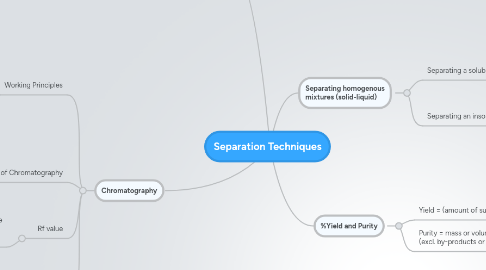
1. Separating Heterogenous Mixtures
1.1. Based on grain size, magnetic properties and/or colour
1.2. Separation of liquid solution with suspended solid
1.2.1. Filtration
1.2.1.1. liquid particles can pass through the tiny spaces in paper while the solid grains cannot, thus, separating the mixture
1.3. Separating immiscible liquids
1.3.1. Usage of a separating funnel
1.3.1.1. Based on the density of liquids. The liquid with higher density will be at the bottom, which will cause it to pour out of the funnel first, followed by the liquid of lower density.
2. Chromatography
2.1. Working Principles
2.1.1. Based on the fact that particles in the different substances in a dye etc. interact differently with the solid and mobile phases.
2.1.1.1. These particles move at different speeds as they are attracted in varying degrees of intensity to the stationary and mobile phase.
2.1.2. Stationary phase: the absorbing substance (e.g. filter paper etc.)
2.1.3. Mobile phase: the flowing material/eluent
2.2. Types of Chromatography
2.2.1. Paper Chromatography
2.2.1.1. characterizes properties or identifies substances in a mixture, but cannot obtain large quantities of purified substances.
2.2.2. Column chromatography
2.2.2.1. enables separation of large quantity of mixture.
2.3. Rf value
2.3.1. The retardation factor is the ratio between the distance the substance travelled and the location of solvent front
2.4. Particle movement
2.4.1. If a particular solute’s molecules are more strongly attracted to the mobile phase (solvent) than to the stationary phase (paper), the molecules flow with the solvent and travel up the paper.
2.4.2. If the solute’s molecules are more strongly attracted to paper, they will stay mostly attached to paper at a fixed location and will only be occasionally be dragged a short distance by water before sticking to the paper again, leading in a slower rate of progress along the paper.
3. Separating homogenous mixtures (solid-liquid)
3.1. Separating a soluble solid from a solvent
3.1.1. Crystalisation
3.1.2. Evaporation
3.2. Separating an insoluble solid from a solvent
3.2.1. Filtration
3.2.2. If the solid is denser than the liquid
3.2.2.1. Decanting
